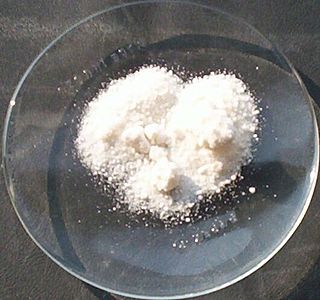
In chemistry, a salt or ionic compound is a chemical compound consisting of an ionic assembly of positively charged cations and negatively charged anions, which results in a neutral compound with no net electric charge. The constituent ions are held together by electrostatic forces termed ionic bonds.

Zirconium dioxide, sometimes known as zirconia, is a white crystalline oxide of zirconium. Its most naturally occurring form, with a monoclinic crystalline structure, is the mineral baddeleyite. A dopant stabilized cubic structured zirconia, cubic zirconia, is synthesized in various colours for use as a gemstone and a diamond simulant.

Nafion is a brand name for a sulfonated tetrafluoroethylene based fluoropolymer-copolymer discovered in the late 1960s by Dr. Walther Grot of DuPont. Nafion is a brand of the Chemours company. It is the first of a class of synthetic polymers with ionic properties that are called ionomers. Nafion's unique ionic properties are a result of incorporating perfluorovinyl ether groups terminated with sulfonate groups onto a tetrafluoroethylene (PTFE) backbone. Nafion has received a considerable amount of attention as a proton conductor for proton exchange membrane (PEM) fuel cells because of its excellent chemical and mechanical stability in the harsh conditions of this application.

Caesium chloride or cesium chloride is the inorganic compound with the formula CsCl. This colorless salt is an important source of caesium ions in a variety of niche applications. Its crystal structure forms a major structural type where each caesium ion is coordinated by 8 chloride ions. Caesium chloride dissolves in water. CsCl changes to NaCl structure on heating. Caesium chloride occurs naturally as impurities in carnallite, sylvite and kainite. Less than 20 tonnes of CsCl is produced annually worldwide, mostly from a caesium-bearing mineral pollucite.

Bismuth(III) oxide is a compound of bismuth, and a common starting point for bismuth chemistry. It is found naturally as the mineral bismite (monoclinic) and sphaerobismoite, but it is usually obtained as a by-product of the smelting of copper and lead ores. Dibismuth trioxide is commonly used to produce the "Dragon's eggs" effect in fireworks, as a replacement of red lead.

A protonic ceramic fuel cell or PCFC is a fuel cell based around a ceramic, solid, electrolyte material as the proton conductor from anode to cathode. These fuel cells produce electricity by removing an electron from a hydrogen atom, pushing the charged hydrogen atom through the ceramic membrane, and returning the electron to the hydrogen on the other side of the ceramic membrane during a reaction with oxygen. The reaction of many proposed fuels in PCFCs produce electricity and heat, the latter keeping the device at a suitable temperature. Efficient proton conductivity through most discovered ceramic electrolyte materials require elevated operational temperatures around 600-700 degrees Celsius, however intermediate temperature ceramic fuel cells and lower temperature alternative are an active area of research. In addition to hydrogen gas, the ability to operate at intermediate and high temperatures enables the use of a variety of liquid hydrogen carrier fuels, including: ammonia, and methane. The technology shares the thermal and kinetic advantages of high temperature molten carbonate and solid oxide fuel cells, while exhibiting all of the intrinsic benefits of proton conduction in proton-exchange membrane fuel cells (PEMFC) and phosphoric acid fuel cells (PAFC). PCFCs exhaust water at the cathode and unused fuel, fuel reactant products and fuel impurities at the anode. Common chemical compositions of the ceramic membranes are barium zirconate (BaZrO3), caesium dihydrogen phosphate (CsH2PO4), and complex solid solutions of those materials with other ceramic oxides. The acidic oxide ceramics are sometimes broken into their own class of protonic ceramic fuel cells termed "solid acid fuel cells".
Indium(III) sulfate (In2(SO4)3) is a sulfate salt of the metal indium. It is a sesquisulfate, meaning that the sulfate group occurs 11/2 times as much as the metal. It may be formed by the reaction of indium, its oxide, or its carbonate with sulfuric acid. An excess of strong acid is required, otherwise insoluble basic salts are formed. As a solid indium sulfate can be anhydrous, or take the form of a pentahydrate with five water molecules or a nonahydrate with nine molecules of water. Indium sulfate is used in the production of indium or indium containing substances. Indium sulfate also can be found in basic salts, acidic salts or double salts including indium alum.

In materials science, fast ion conductors are solid conductors with highly mobile ions. These materials are important in the area of solid state ionics, and are also known as solid electrolytes and superionic conductors. These materials are useful in batteries and various sensors. Fast ion conductors are used primarily in solid oxide fuel cells. As solid electrolytes they allow the movement of ions without the need for a liquid or soft membrane separating the electrodes. The phenomenon relies on the hopping of ions through an otherwise rigid crystal structure.

Ammonium bisulfate, also known as ammonium hydrogen sulfate, is a white, crystalline solid with the formula (NH4)HSO4. This salt is the product of the half-neutralization of sulfuric acid by ammonia.

Ionic conductivity is a measure of a substance's tendency towards ionic conduction. Ionic conduction is the movement of ions. The phenomenon is observed in solids and solutions. Ionic conduction is one mechanism of current.
Rubidium silver iodide is a ternary inorganic compound with the formula RbAg4I5. Its conductivity involves the movement of silver ions within the crystal lattice. It was discovered while searching for chemicals which had the ionic conductivity properties of alpha-phase silver iodide at temperatures below 146 °C for AgI.

Yttria-stabilized zirconia (YSZ) is a ceramic in which the cubic crystal structure of zirconium dioxide is made stable at room temperature by an addition of yttrium oxide. These oxides are commonly called "zirconia" (ZrO2) and "yttria" (Y2O3), hence the name.

Solid-state ionics is the study of ionic-electronic mixed conductor and fully ionic conductors and their uses. Some materials that fall into this category include inorganic crystalline and polycrystalline solids, ceramics, glasses, polymers, and composites. Solid-state ionic devices, such as solid oxide fuel cells, can be much more reliable and long-lasting, especially under harsh conditions, than comparable devices with fluid electrolytes.
Sossina M. Haile is an American chemist, known for developing the first solid acid fuel cells. She is a professor of materials science and engineering at Northwestern University, Illinois, US.

Berkelium forms a number of chemical compounds, where it normally exists in an oxidation state of +3 or +4, and behaves similarly to its lanthanide analogue, terbium. Like all actinides, berkelium easily dissolves in various aqueous inorganic acids, liberating gaseous hydrogen and converting into the trivalent oxidation state. This trivalent state is the most stable, especially in aqueous solutions, but tetravalent berkelium compounds are also known. The existence of divalent berkelium salts is uncertain and has only been reported in mixed lanthanum chloride-strontium chloride melts. Aqueous solutions of Bk3+ ions are green in most acids. The color of the Bk4+ ions is yellow in hydrochloric acid and orange-yellow in sulfuric acid. Berkelium does not react rapidly with oxygen at room temperature, possibly due to the formation of a protective oxide surface layer; however, it reacts with molten metals, hydrogen, halogens, chalcogens and pnictogens to form various binary compounds. Berkelium can also form several organometallic compounds.
Rubidium hydrogen sulfate, sometimes referred to as rubidium bisulfate, is the half neutralized rubidium salt of sulfuric acid. It has the formula RbHSO4.
Solid acid fuel cells (SAFCs) are a class of fuel cells characterized by the use of a solid acid material as the electrolyte. Similar to proton exchange membrane fuel cells and solid oxide fuel cells, they extract electricity from the electrochemical conversion of hydrogen- and oxygen-containing gases, leaving only water as a byproduct. Current SAFC systems use hydrogen gas obtained from a range of different fuels, such as industrial-grade propane and diesel. They operate at mid-range temperatures, from 200 to 300 °C.
Lithium lanthanum zirconium oxide (LLZO, Li7La3Zr2O12) or lithium lanthanum zirconate is a lithium-stuffed garnet material that is under investigation for its use in solid-state electrolytes in lithium-based battery technologies. LLZO has a high ionic conductivity and thermal and chemical stability against reactions with prospective electrode materials, mainly lithium metal, giving it an advantage for use as an electrolyte in solid-state batteries. LLZO exhibits favorable characteristics, including the accessibility of starting materials, cost-effectiveness, and straightforward preparation and densification processes. These attributes position this zirconium-containing lithium garnet as a promising solid electrolyte for all-solid-state lithium-ion rechargeable batteries.

Lithium aluminium germanium phosphate, typically known with the acronyms LAGP or LAGPO, is an inorganic ceramic solid material whose general formula is Li
1+xAl
xGe
2-x(PO
4)
3. LAGP belongs to the NASICON family of solid conductors and has been applied as a solid electrolyte in all-solid-state lithium-ion batteries. Typical values of ionic conductivity in LAGP at room temperature are in the range of 10–5 - 10–4 S/cm, even if the actual value of conductivity is strongly affected by stoichiometry, microstructure, and synthesis conditions. Compared to lithium aluminium titanium phosphate (LATP), which is another phosphate-based lithium solid conductor, the absence of titanium in LAGP improves its stability towards lithium metal. In addition, phosphate-based solid electrolytes have superior stability against moisture and oxygen compared to sulfide-based electrolytes like Li
10GeP
2S
12 (LGPS) and can be handled safely in air, thus simplifying the manufacture process. Since the best performances are encountered when the stoichiometric value of x is 0.5, the acronym LAGP usually indicates the particular composition of Li
1.5Al
0.5Ge
1.5(PO
4)
3, which is also the typically used material in battery applications.
The phosphate sulfates are mixed anion compounds containing both phosphate and sulfate ions. Related compounds include the arsenate sulfates, phosphate selenates, and arsenate selenates.














